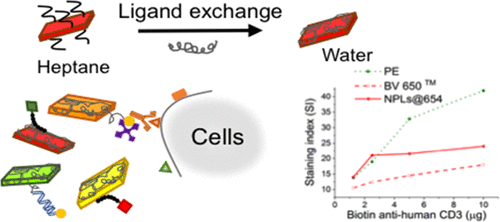当前位置:
X-MOL 学术
›
ACS Appl. Mater. Interfaces
›
论文详情
Our official English website, www.x-mol.net, welcomes your
feedback! (Note: you will need to create a separate account there.)
Semiconductor Nanoplatelets: A New Class of Ultrabright Fluorescent Probes for Cytometric and Imaging Applications
ACS Applied Materials & Interfaces ( IF 8.3 ) Pub Date : 2018-06-19 00:00:00 , DOI: 10.1021/acsami.8b07143 Djamila Kechkeche 1, 2 , Edgar Cao 2 , Chloé Grazon 2 , Filippo Caschera 2 , Vincent Noireaux 3 , Marie-Laurence Baron Niel 2 , Benoit Dubertret 1
ACS Applied Materials & Interfaces ( IF 8.3 ) Pub Date : 2018-06-19 00:00:00 , DOI: 10.1021/acsami.8b07143 Djamila Kechkeche 1, 2 , Edgar Cao 2 , Chloé Grazon 2 , Filippo Caschera 2 , Vincent Noireaux 3 , Marie-Laurence Baron Niel 2 , Benoit Dubertret 1
Affiliation

|
Fluorescent semiconductor nanoplatelets (NPLs) are a new generation of fluorescent probes. NPLs are colloidal two-dimensional materials that exhibit several unique optical properties, including high brightness, photostability, and extinction coefficients, as well as broad excitation and narrow emission spectra from the visible to the near-infrared spectrum. All of these exceptional fluorescence properties make NPLs interesting nanomaterials for biological applications. However, NPLs are synthesized in organic solvents and coated with hydrophobic ligands that render them insoluble in water. A current challenge is to stabilize NPLs in aqueous media compatible with biological environments. In this work, we describe a novel method to disperse fluorescent NPLs in water and functionalize them with different biomolecules for biodetection. We demonstrate that ligand exchange enables the dispersion of NPLs in water while maintaining optical properties and long-term colloidal stability in biological environments. Four different colors of NPLs were functionalized with biomolecules by random or oriented conformations. For the first time, we report that our NPLs have a higher brightness than that of standard fluorophores, like phycoerythrin or Brilliant Violet 650 (BV 650), for staining cells in flow cytometry. These results suggest that NPLs are an interesting alternative to common fluorophores for flow cytometry and imaging applications in multiplexed cellular targeting.
中文翻译:

半导体纳米血小板:用于细胞计数和成像应用的新型超亮荧光探针
荧光半导体纳米片(NPL)是新一代的荧光探针。NPL是胶态二维材料,具有多种独特的光学特性,包括高亮度,光稳定性和消光系数,以及从可见光谱到近红外光谱的宽激发光谱和窄发射光谱。所有这些优异的荧光特性使NPL成为生物学应用中有趣的纳米材料。但是,不良贷款是在有机溶剂中合成的,并涂有疏水性配体,使其不溶于水。当前的挑战是在与生物环境相容的水性介质中稳定不良贷款。在这项工作中,我们描述了一种将荧光不良贷款分散在水中并用不同的生物分子对其进行功能化以进行生物检测的新方法。我们证明了配体交换使NPLs分散在水中,同时在生物环境中保持光学性能和长期胶体稳定性。NPL的四种不同颜色通过随机或定向构象用生物分子进行功能化。我们首次报告,我们的不良贷款用于流式细胞仪染色的细胞比标准荧光团(如藻红蛋白或亮紫色650(BV 650))具有更高的亮度。这些结果表明,NPL是流式细胞术和多细胞靶向成像应用中常见荧光团的有趣替代品。NPL的四种不同颜色通过随机或定向构象用生物分子进行功能化。我们首次报告,我们的不良贷款用于流式细胞仪染色的细胞比标准荧光团(如藻红蛋白或亮紫色650(BV 650))具有更高的亮度。这些结果表明,NPL是流式细胞术和多细胞靶向成像应用中常见荧光团的有趣替代品。NPL的四种不同颜色通过随机或定向构象用生物分子功能化。我们首次报告,我们的不良贷款用于流式细胞仪染色的细胞比标准荧光团(如藻红蛋白或亮紫色650(BV 650))具有更高的亮度。这些结果表明,NPL是流式细胞术和多细胞靶向成像应用中常见荧光团的有趣替代品。
更新日期:2018-06-19
中文翻译:

半导体纳米血小板:用于细胞计数和成像应用的新型超亮荧光探针
荧光半导体纳米片(NPL)是新一代的荧光探针。NPL是胶态二维材料,具有多种独特的光学特性,包括高亮度,光稳定性和消光系数,以及从可见光谱到近红外光谱的宽激发光谱和窄发射光谱。所有这些优异的荧光特性使NPL成为生物学应用中有趣的纳米材料。但是,不良贷款是在有机溶剂中合成的,并涂有疏水性配体,使其不溶于水。当前的挑战是在与生物环境相容的水性介质中稳定不良贷款。在这项工作中,我们描述了一种将荧光不良贷款分散在水中并用不同的生物分子对其进行功能化以进行生物检测的新方法。我们证明了配体交换使NPLs分散在水中,同时在生物环境中保持光学性能和长期胶体稳定性。NPL的四种不同颜色通过随机或定向构象用生物分子进行功能化。我们首次报告,我们的不良贷款用于流式细胞仪染色的细胞比标准荧光团(如藻红蛋白或亮紫色650(BV 650))具有更高的亮度。这些结果表明,NPL是流式细胞术和多细胞靶向成像应用中常见荧光团的有趣替代品。NPL的四种不同颜色通过随机或定向构象用生物分子进行功能化。我们首次报告,我们的不良贷款用于流式细胞仪染色的细胞比标准荧光团(如藻红蛋白或亮紫色650(BV 650))具有更高的亮度。这些结果表明,NPL是流式细胞术和多细胞靶向成像应用中常见荧光团的有趣替代品。NPL的四种不同颜色通过随机或定向构象用生物分子功能化。我们首次报告,我们的不良贷款用于流式细胞仪染色的细胞比标准荧光团(如藻红蛋白或亮紫色650(BV 650))具有更高的亮度。这些结果表明,NPL是流式细胞术和多细胞靶向成像应用中常见荧光团的有趣替代品。











































 京公网安备 11010802027423号
京公网安备 11010802027423号